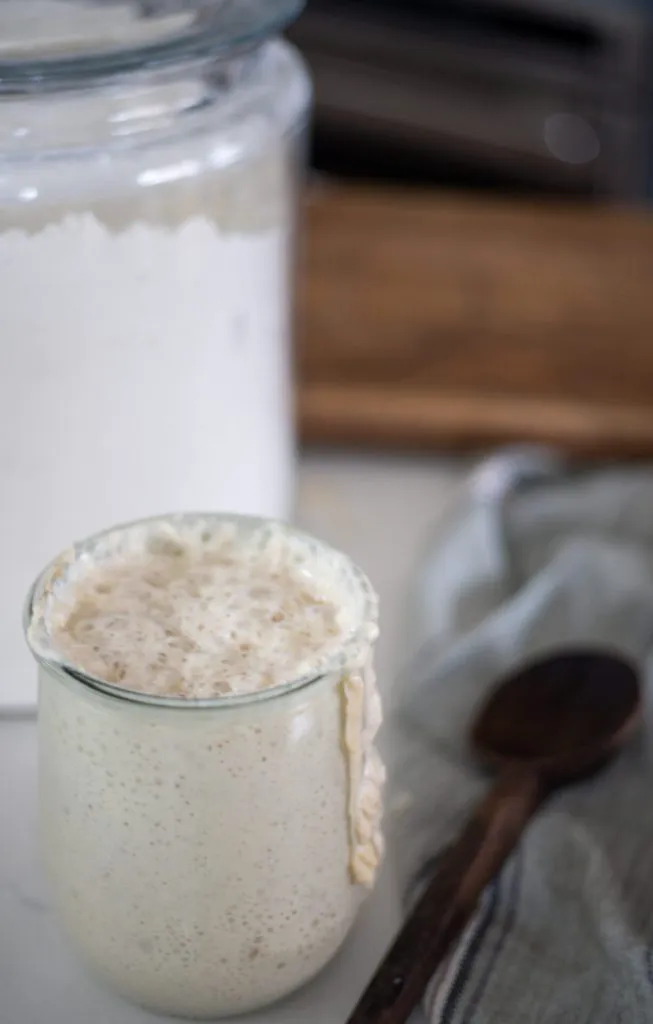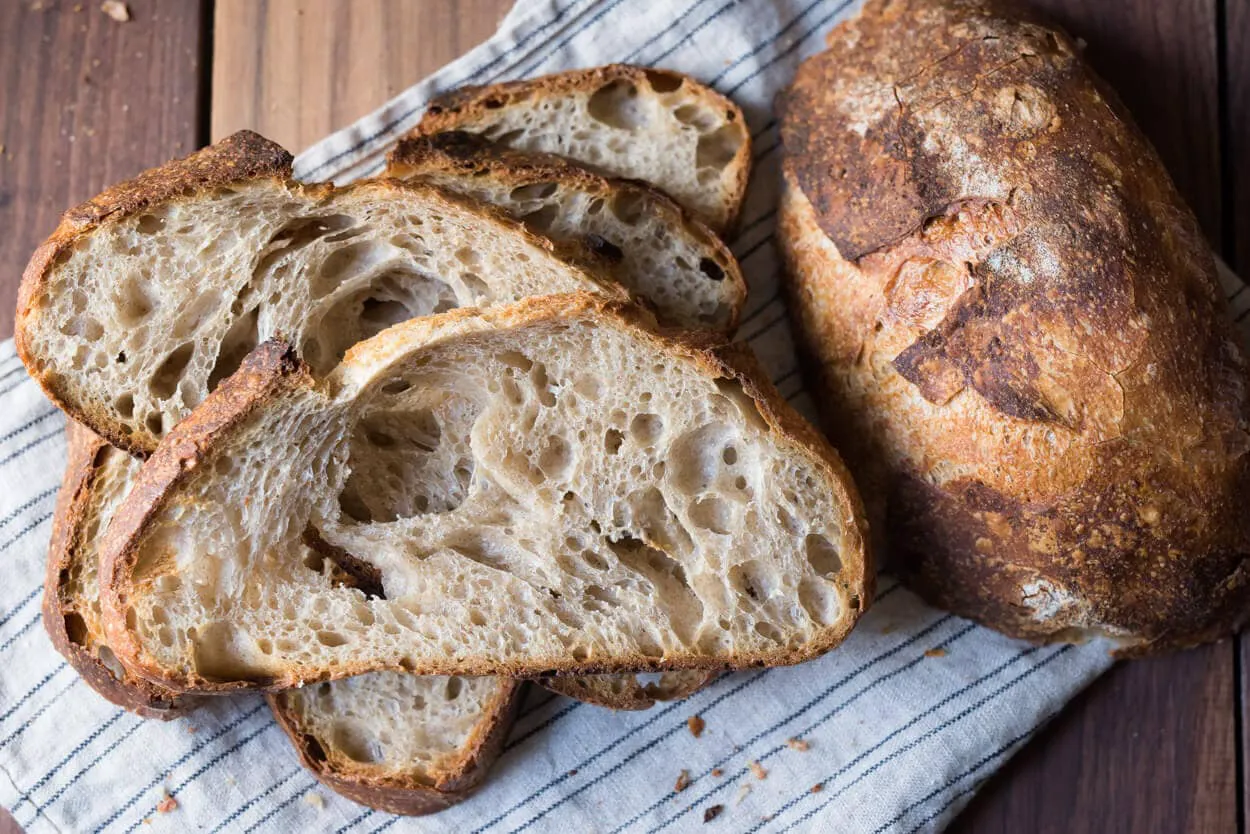Beginner's Guide to Artisan Sourdough Bread: Delicious & Easy Recipes
Master the Art of Sourdough Bread: Simple Recipes for Beginners
Master the Art of Sourdough Bread: Simple Recipes for Beginners
FAQ
How long does it take to make sourdough artisan bread?
It takes anywhere between 6-24 hours to make sourdough artisan bread, depending on the strength of your sourdough starter, the hydration of your dough, and the temperature of your home. I use a proofing box to control the temperature and humidity and speed the baking process up.
What type of flour should I use to bake sourdough bread?
How do I know when my dough is done fermenting during bulk fermentation?
When the dough is done fermenting, it will have doubled in size and pass the poke test. Poke the dough, if it bounces back quickly because it is light and springy, it is ready to shape.
How can I achieve an open crumb when baking sourdough artisan bread?
For an open crumb (lots of big holes) loaf, make a higher hydration dough. This means you will omit some of the flour in a standard recipe so the dough is stickier from the get-go. Also, cut down to 2 stretch and folds and allow the dough to bulk ferment longer than usual. Use bread flour for an open crumb loaf.
What is Sourdough Bread?
Sourdough bread is bread that has been leavened naturally, meaning it has been leavened by a sourdough starter as opposed to by commercial yeast or a chemical leavening agent such as baking powder or baking soda.
A sourdough starter is a fermented mix of flour and water containing wild yeast and bacteria (lactobacilli). Provided it is healthy and active, a sourdough starter is what will make your bread rise.
You can make a sourdough starter from scratch in just about a week. I only recommend doing so if it currently is summer (or a very warm fall) where you are. While it is immensely satisfying to build a starter from scratch and subsequently use it to make a beautiful loaf of bread, I am a huge proponent of purchasing one for a few reasons, namely: when you purchase a starter, you are guaranteed to have a strong, vigorous starter from the start. In other words, you can start baking with confidence right away.
Here are three online sources for reasonably priced sourdough starters:
- Breadtopia
- King Arthur Flour
- Cultures for Health
Artisan Sourdough Made Simple…
One of the biggest problems in the sourdough world right now is that sourdough has been over-complicated – big time! Sourdough bread is simply bread that is made with a sourdough starter (wild yeast) rather than commercial, store-bought yeast. Yep, that’s all a sourdough starter is – wild yeast.
I have an entire blog post – The Ultimate Guide to Sourdough Starters – breaking down the history of wild yeast and how to make and use it. But to sum it up, for all of history before the past 150 years or so, it wasn’t possible to buy yeast. You had to make your own. And odds are, this skill of making your own yeast was known by almost every baker or common lady in the village.
Making your own yeast (aka sourdough starter) is as simple as combining a little flour and water in a jar or bowl and letting it sit on the counter at room temperature for several hours until it bubbles up. Then, you use the bubbly yeast, leave just enough in the jar to cover the sides, and “activate” the next round of flour and water you add to the jar. It’s that easy.
But for the new baker, the art of sourdough seems easier said than done, right? That’s why I’m here – to make this process super simple for you so you can not only have a thriving jar of homemade yeast (sourdough starter) but also make beautiful, tasty loaves of artisan bread. Trust me, you don’t have to be a professionally trained chef to pull a loaf like this out of your oven every morning.
I may receive a small commission for items purchased through affiliate links in this post at no additional cost to you.
Step 6: Baking the Bread in a dutch oven
The next morning, it's time to bake! No need to preheat the oven for an hour—I use a cold oven baking method, and it works beautifully.
Baking Steps:
- Place the dough on parchment paper.
- Score the top with a sharp knife or bread lame. (I've even used scissors)
- Bake in a cold oven at 450°F for 55 minutes with the lid on.
- Remove the lid and bake for an additional 15 minutes to brown the top.
To prevent burning, I place an Instant Pot trivet inside my Dutch oven and a baking sheet underneath the pan in the oven.
If you don't have two dutch ovens to bake both loaves at the same time, you can follow the steps below for baking the second loaf.
- Place the dough on parchment paper.
- Score the top with a sharp knife or bread lame. (I've even used scissors)
- Bake in the preheatedoven at 450°F for 30 minutes with the lid on.
- Remove the lid and bake for an additional 15 minutes to brown the top.
The Final Result
When cutting, I recommend slicing the loaf down the middle first, then cutting smaller slices from each half. This makes slicing easier and more even.
And there you have it—delicious, homemade sourdough with minimal effort!
I'll soon have a sandwich bread recipe, so be watching for that!
Frequently Asked Questions
1. How do I know my starter is ready to use?
If it floats in water, it’s ready! Bubbling and doubling in size are also good signs.
2. Do I have to do stretch and folds exactly on time?
Nope! If life gets busy, it’s totally fine to space them out as needed.
3. Can I use whole wheat flour instead of all-purpose?
Yes, but it the ratios will be different. Experiment to see what works best for you.



Tegs:
Search
Recent Posts
-
The Ultimate Guide to Choosing the Best Sewing Machine for Beginners
Apr 14 2025
-
Learn to Crochet a Lovey for Beginners: A Simple and Adorable Project
Apr 15 2025
-
Master the Basics of Knitting with This Guide to Essential Terms
Apr 17 2025
-
Create a Stunning Macrame Plant Hanger: A Beginner's Guide
Apr 18 2025
Subscribe to Updates
Get the latest posts and fashion insights directly in your inbox.